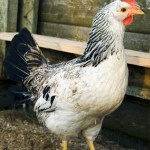chicken
Image of chicken egg from Wikimedia Commons.
Turns out the egg is an important phase. A new study published this month in American Journal of Physiology - Regulatory, Integrative and Comparative Physiology looked at what happens in the egg when a chicken fetus was exposed to low oxygen (hypoxia) conditions. In mammals, this can occur as a result of maternal hypoxia, preeclampsia as well as anemia in the fetus resulting in less red blood cells that can carry oxygen. Understanding this is important as restricted fetal growth is associated with an increased risk…
If you have not already had a chance to see it, the T. Rex Autopsy airing on the National Geographic channel is a must-see! They literally created a model of T. Rex based on available evidence about T. Rex and other dinosaurs as well as evidence from modern birds and then performed an "autopsy". The conclusion: T. Rex was basically a 'big angry chicken' - Love it!!
It will be airing again tomorrow night at 10/9 central.
For more information and a sneak preview:
Images from National Geographic website.
Brandy Velten (doctoral student) and Dr. Kenneth Welch (Comparative Physiologist) from the University of Toronto wanted to know whether birds with very different speeds at which they flaps their wings (i.e. wingbeat frequencies) had correspondingly varying types of myosin proteins in their muscles. Their findings were published in the American Journal of Physiology last month.
In their study they compared ruby-throated hummingbirds and zebra finches which reportedly have some of the highest wingbeat frequencies (20-60Hz). As you can imagine, their flight muscles are made up of almost…
FDA is looking for your help to determine source of illnesses and deaths related to dog jerky treats
Image from Vin News Service (http://news.vin.com/VINNews.aspx?articleId=22697)
The FDA is calling for help to determine the source of roughly 580 deaths and over 3600 illnesses (gastrointestinal and kidney) related to jerky treats that were made in China. The mystery dates back to 2007 when illnesses were first being reported by pet owners. Most of the victims have been dogs, although 10 cats have become sick from eating these treats as well.The FDA has tested treats for contaminants including chemical, microbiological/bacterial, antibiotics, metals, and pesticides in addition…
If you haven't yet read Maryn McKenna's riveting Atlantic article "How Your Chicken Dinner is Creating a Drug-Resistant Superbug," you should. McKenna, working with the with the Food and Environment Reporting Network, has delved into research that's been accumulating about the association between the extensive use of antibiotics in poultry and the increase in drug-resistant urinary tract infections.
A quick bit of background: For decades, health officials and advocates have been concerned about the overuse of antibiotics. The more you use an antibiotic, the more quickly bacteria resistant to…
Earlier this week I wrote about the developmental and evolutionary origins of large number representation. A series of studies in human infants, monkeys, rats, and fish demonstrated that animals and humans spontaneously represent large (>4), abstract, approximate numerosities. Animals, human infants, and human adults, show the same ratio signatures (based on Weber's Law). Adult tamarins are on par with 9-month-old human infants. With age or training, discriminability becomes more precise, and the the critical ratio is reduced a bit. There is good evidence that the large number…
First of all, may I ask which New York Times editor was responsible for permitting the coinage "femivore" to pass into language. Talk about illiterate (linguistically a "femivore" would be someone who ate women) and uneuphonious - yes, yes, I get that you want to get a Michael Pollan reference in there somehow, but come on... any writer worth her salt could do better than that.
Now to the meat of the thing - the essay, which profiles Shannon Hayes's book _Radical Homemakers_ attempts to argue that focusing on food has given women a new set of choices.
Hayes pointed out that the original "…
tags: evolution, evolutionary biology, gynandromorph, bilateral gynandromorph bird, half-sider, mixed-sex chimaera, sex determination, molecular biology, genetics, developmental biology, endocrinology, birds, chicken, Gallus gallus, ornithology, researchblogging.org,peer-reviewed research, peer-reviewed paper, journal club
Half-sider.
Almost exactly one year ago, hundreds of American birders
were thrilled by sightings and photographs of this remarkable
Northern Cardinal, or Redbird, Cardinalis cardinalis,
photographed in Warrenton, VA.
Image: DW Maiden, 2 March 2009.
I'll never forget…
The animal on the right is no ordinary chicken. Its right half looks like a hen but its left half (with a larger wattle, bigger breast, whiter colour and leg spur) is that of a cockerel. The bird is a 'gynandromorph', a rare sexual chimera. Thanks to three of these oddities, Debiao Zhao and Derek McBride from the University of Edinburgh have discovered a truly amazing secret about these most familiar of birds - every single cell in a chicken's body is either male or female. Each one has its own sexual identity. It seems that becoming male or female is a very different process for birds than…
Students at Shiga high school in Japan were amazed when a chicken of theirs laid a humungous egg which was 8.1 centimeters high and weighed 158 grams (Sorry for the metric measurements. In Fahrenheit, those numbers translate roughly to 14 feet tall and over 2200 lbs.). They were so amazed that they planned on displaying the monster egg. Someone, however, had the idea to cut back some of the shell to see what was inside and lo and behold, they encountered another, medium sized egg! Assistant principal Toshitaka Minami announced the finding to the school last week.
Who wants a whale meat…
Photograph of a chicken. Click to see larger version. From PLOS article cited in blog post.
Where and when were chickens domesticated?
From whence the humble chicken? Gallus gallus is a domesticated chicken-like bird (thus, the name "chicken") that originates in southeast Asia. Ever since Darwin we've known that the chicken originated in southeast Asia, although the exact details of which one or more of several possible jungle fowls is the primal form has been debated. The idea that more than one wild species contributed to the early chicken has been on the table for a long time,…



